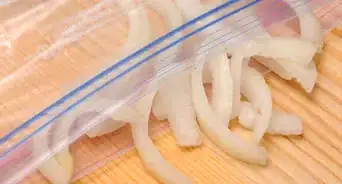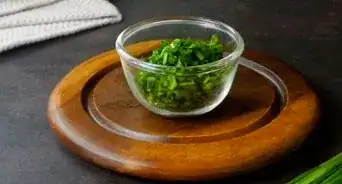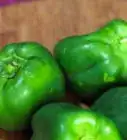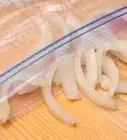This article was co-authored by Olivia Choong. Olivia Choong is a Plant and Gardening Specialist and the Owner of The Tender Gardener. With more than six years of experience, she specializes in gardening, permaculture, and self-sufficient and low-impact living practices. Her work has been featured in media outlets such as The Straits Times and Channel NewsAsia (CNA). Olivia holds a Bachelor of Mass Communications in PR and Journalism from Murdoch University.
wikiHow marks an article as reader-approved once it receives enough positive feedback. In this case, several readers have written to tell us that this article was helpful to them, earning it our reader-approved status.
This article has been viewed 292,113 times.
For anyone who uses plenty of onions in their cooking, having some stashed away in your freezer means you always have some on hand when you need it. However, it's important to prepare the onions properly before you freeze them if you want them to maintain their flavor. While you can easily freeze chopped onions, you may want to blanch or puree them beforehand to help boost their flavor when you go to use them.
Steps
Freezing Onions the Easy Way
-
1Peel and chop the onions. To prepare the onions for freezing, use a sharp knife to cut off the top ½-inch (1.3 cm). Next, slice the onion in half. Peel off the papery skin, and then chop the onion to the size you prefer.[1] .
- It’s not a good idea to chop the onions any smaller than into ½-inch (1.3 cm) pieces because they may wind up becoming encased in ice when you freeze them if they’re too small.
- You can slice the onions instead of chopping them if you’re freezing them for use in dishes such as fajitas.
-
2Place the onions in a freezer bag. When you’ve chopped the onions to your desired size, transfer them to a plastic freezer bag. Make sure to place them in the bag in a single, flat layer to prevent them from clumping together when they freeze. Squeeze all the air out of the bag, and seal it.
- If you’re freezing a large number of onions, prevent them from sticking together when frozen by placing them in a single layer on a shallow baking dish. Freeze them like that for two to three hours, and when they’re partially frozen, you can place them in the freezer bag without worrying about them clumping together.
- Be sure to use plastic bags that are thick enough to protect the onions from freezer burn and keep the onion scent contained in the bag. If your bags seem too thin, double them up.
Advertisement -
3Label the bag and freeze. Before throwing the onions in your freezer, use a pen or marker to label the bag with the date, type of onion, and when you should use them by. Place the bag flat in the freezer, making sure that the onions are still in a single layer as you position them.
- You can keep onions in your freezer for up to 6 months.
- If you have multiple bags of onions that you’re freezing, you can stack them on top of one another to save space in the freezer. Just make sure that the onions in each bag are in a flat, single layer.
Blanching Onions Before Freezing
-
1Peel and chop the onions. Prepare the onions by trimming off the top and the bottom with a sharp knife. Next, remove the papery skin by peeling it off. Use the knife to chop the onions to the size that you prefer.[2]
-
2Bring a pot of water to a boil. Fill a large stockpot with water, and place it on the stove. Set the burner to high, and allow the water to come to a full boil, which should take approximately 10 to 20 minutes depending on how much water you’re using.[3]
- The amount of water that you should boil depends on how many onions you’re blanching. For every pound (373 g), use 1 (3.8 l) gallon of water.
-
3Add the onions to the pot and boil for several minutes. Once the water has come to a boil, place the onions in the pot. Cover the pot, and allow the onions to cook for 3 to 7 minutes, depending on how many you’re blanching.[4]
- The more onions that you’re blanching, the longer you should leave them in the boiling water.
- With chopped onions, it’s easier to place them in a wire basket or perforated metal strainer and then set them in the boiling water. That way, you can quickly and easily remove them when they’re done. If you don’t have a basket or strainer, remove them from the boiling water with a slotted spoon.
-
4Transfer the onions to a bowl of cold water. As soon as you remove the onions from the boiling water, place them in a bowl of ice or cold water. Let the onions sit in the cold water for the same amount of time that you boiled them to stop the cooking process.[5]
- The ice or cold water that you place the onions in after boiling shouldn’t be more than 60 degrees Fahrenheit (15 degrees Celsius).
- While the onions are in the cold water, stir them several times to ensure that they’re cooling evenly.
-
5Drain the onions and place them in freezer bags. When the onions have cooled long enough, drain them thoroughly in a colander. Shake well to remove the excess water, and blot with a clean towel. When they’re dry, transfer them to freezer bags and place them in the freezer.[6]
- Be sure to label the freezer bag with the date so you can keep track of how long the onions are in your freezer.
Pureeing Onions Before Freezing
-
1Peel and cut the onions into pieces. Use a knife to trim off the top and bottom of the onions so you can easily peel off the papery skin. Next, cut the onions into pieces to prepare them for pureeing. You don’t need to chop or dice the onion, but cut it into chunks that are small enough to fit in the blender.[7]
- Use the pitcher from your blender as a guide for how small you should cut your onion. If it’s not very large, you should cut the onion into small pieces. In a large pitcher, cutting it into eighths may be sufficient.
-
2Place the onions in a blender and puree. When you’ve cut all the onions into pieces, place them in a blender. Use the puree setting, and hold down on the button until the onions are ground into a thick but smooth puree.[8]
- If you’re freezing a large number of onions, you’ll probably need to puree them in batches. Overfilling the blender’s pitcher makes it more difficult for the appliance to puree effectively.
- If your blender’s motor isn’t very strong, you may need to push down on the onions as you’re pureeing to bring them into contact with the blades. To do so, set the handle of a metal ladle through the opening in the blender’s lid before placing it on the pitcher. The rounded end of the ladle should be inside the pitcher, so when you start pureeing, you can press down on the onions with the ladle. Because the bottom is rounded it won’t get caught in the blades.[9]
-
3Transfer the puree to ice cube trays and freeze. Once you’ve pureed the onions, use a spoon to carefully pour the puree into a clean ice cube tray. Place the tray in the freezer, and allow the puree to fully freeze, which should take approximately four hours.[10]
- Be sure to cover the ice cube tray with a sheet of plastic wrap to prevent the onion smell from reaching the other food in the freezer.
-
4Move the onion ice cubes to a plastic bag and leave them in the freezer. After the pureed onion ice cubes have frozen fully, carefully remove them from the tray. Place them in a plastic freezer bag, and store them in the freezer until you’re ready to use them.[11]
- Remember to label the bag with the date that you’re freezing the onions, so you can be sure to use them within 6 months.
- These pureed onion cubes are ideal for adding to sauces, gravies, and soups.
Community Q&A
-
QuestionCan I freeze whole onions?
 Community AnswerYou can, but they will be harder to slice after freezing - too hard when frozen, too mushy when thawed.
Community AnswerYou can, but they will be harder to slice after freezing - too hard when frozen, too mushy when thawed. -
QuestionCan I cook onions before freezing them?
 Community AnswerYes, but as this article suggests, they should be drained, spread flat and frozen before you put them in freezer bags. Don't chop them too small. Quartering an onion (depending on the size of the onion) is probably the smallest you should do. If they are any smaller, you may lose some of the "fresh" flavor of the onions. Cooking thoroughly may lessen the flavor also. Blanching the onions usually works better in keeping the flavor.
Community AnswerYes, but as this article suggests, they should be drained, spread flat and frozen before you put them in freezer bags. Don't chop them too small. Quartering an onion (depending on the size of the onion) is probably the smallest you should do. If they are any smaller, you may lose some of the "fresh" flavor of the onions. Cooking thoroughly may lessen the flavor also. Blanching the onions usually works better in keeping the flavor. -
QuestionCan I use a Seal-a-Meal to store onions in my freezer?
 Community AnswerYes, you can. I usually look up the safe handling directions, but nearly any food can be frozen using a Seal-A-Meal. However, soups should be frozen in an approved freezer container. If you have the attachment for your Seal-A-Meal that will remove the air from the container, your soups will stay fresher for a longer period of time.
Community AnswerYes, you can. I usually look up the safe handling directions, but nearly any food can be frozen using a Seal-A-Meal. However, soups should be frozen in an approved freezer container. If you have the attachment for your Seal-A-Meal that will remove the air from the container, your soups will stay fresher for a longer period of time.
Things You'll Need
Easy Frozen Onions
- A knife
- Plastic freezer bags
Blanched Frozen Onions
- A knife
- A large stockpot
- A large bowl
- A colander
- A towel
- Plastic freezer bags
Pureed Frozen Onions
- A knife
- A blender
- An ice cube tray
- A spoon
- Plastic freezer bags
References
- ↑ http://www.realsimple.com/food-recipes/cooking-tips-techniques/preparation/chop-peel-onion
- ↑ http://garden.org/learn/articles/view/502/
- ↑ http://www.extension.umn.edu/food/food-safety/preserving/vegetables-herbs/blanching-vegetables/
- ↑ http://www.extension.umn.edu/food/food-safety/preserving/vegetables-herbs/blanching-vegetables/
- ↑ http://www.extension.umn.edu/food/food-safety/preserving/vegetables-herbs/blanching-vegetables/
- ↑ http://garden.org/learn/articles/view/502/
- ↑ http://garden.org/learn/articles/view/502/
- ↑ http://garden.org/learn/articles/view/502/
- ↑ http://www.seriouseats.com/2010/07/how-to-make-a-vegetable-puree.html
About This Article
To freeze onions, start by peeling and chopping the onions to your preferred size. Be sure to keep the pieces larger than 1/2 an inch to prevent ice from forming on them in the freezer. Then, place the onions in a large, resealable freezer bag in a single, flat layer. Press out all the air before you seal it, and mark the bag with the date you froze them. Place the bag in the freezer and use the onions within 6 months.






















































